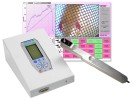Authors
CAN Ismail, R Suppian, CBA Aziz, I Long
Lab
School of Health Sciences, Universiti Sains Malaysia Health Campus, Kubang Kerian, Malaysia
Journal
Journal of Diabetes & Metabolic Disorders
Abstract
AimThis study investigates the effects of minocycline (an inhibitor of microglial activation) administration on the expression level of spinal BDNF and DREAM proteins in diabetic neuropathic pain (DNP) rats. Methods The rats were divided into four groups (n =_16): non-diabetic control, diabetic control and diabetic rats receiving minocycline (80 microg/day or 160 _g/day). The diabetic rat model was induced by intraperitoneal injection of streptozotocin (60 mg/kg STZ). Tactile allodynia was assessed on day-0 (baseline), day-14 (pre-intervention) and day-22 (post-intervention). Minocycline at doses of 80 _g and 160 _g were given intrathecally from day-15 until day-21. On day-23, formalin test was conducted to assess nociceptive behaviour response. The spinal expression of OX-42 and level of BDNF and DREAM proteins were detected by immunohistochemistry and western blot analyses. Results Diabetes rats showed significant tactile allodynia and nociceptive behaviour. These were accompanied by augmented expression of spinal OX-42, BDNF and DREAM protein levels. Both doses of minocycline attenuated tactile allodynia and nociceptive behaviour and also suppressed the diabetic-induced increase in spinal expressions of OX-42, BDNF and DREAM proteins. Conclusion This study revealed that minocycline could attenuate DNP by modulating spinal BDNF and DREAM protein expressions.
BIOSEB Instruments Used:
Electronic Von Frey 4 (BIO-EVF4),Electronic Von Frey 5 with embedded camera (BIO-EVF5)

 Douleur - Allodynie/Hyperalgésie Thermique
Douleur - Allodynie/Hyperalgésie Thermique Douleur - Spontanée - Déficit de Posture
Douleur - Spontanée - Déficit de Posture Douleur - Allodynie/Hyperalgésie Mécanique
Douleur - Allodynie/Hyperalgésie Mécanique Apprentissage/Mémoire - Attention - Addiction
Apprentissage/Mémoire - Attention - Addiction Physiologie & Recherche Respiratoire
Physiologie & Recherche Respiratoire
 Douleur
Douleur Système Nerveux Central (SNC)
Système Nerveux Central (SNC)  Neurodégénérescence
Neurodégénérescence Système sensoriel
Système sensoriel Système moteur
Système moteur Troubles de l'humeur
Troubles de l'humeur Autres pathologies
Autres pathologies Système musculaire
Système musculaire Articulations
Articulations Métabolisme
Métabolisme Thématiques transversales
Thématiques transversales Bonne année 2025
Bonne année 2025 
